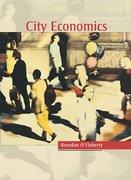4. An urban growth boundary (UGB) is a law that prevents expansion of a city beyond certain...
Question:
4. An urban growth boundary (UGB) is a law that prevents expansion of a city beyond certain boundaries. Suppose a city has a binding UGB—that is, if there were no law, the area devoted to urban uses would be larger. Assume all business activity takes place in the central business district, and all land outside the CBD is used for housing workers who commute to the CBD. All households are identical.
a. Draw the land rent gradient and the density gradient that would prevail if there were no UGB.
b. Since landowners have the option of putting more apartments on a plot of land and using more or less land to produce a unit of housing, you have to distinguish between the rents consumers pay for housing and what the landowners collect per square meter. Draw the gradient of housing rents that consumers actually pay, still assuming no UGB in effect.
c. Consider the open-city case. Suppose the UGB is in effect. Draw the gradient of housing rents that consumers actually pay. How does this compare with the gradient without the UGB? Are consumers better off or worse off? How does the city’s population change?
d. Draw the density gradient when the UGB is in effect.
e. Draw the gradient of rents that landowners collect per square meter.
How does it compare with the gradient without the UGB? Which landowners, if any, are better off? Which landowners, if any, are worse off?
f. In the open-city case, is the UGB a potential Pareto improvement?
g. Now consider the closed-city case. Draw the density gradient with the UGB and compare it with the density gradient without the UGB. How does the city’s population change?
h. For the closed-city case, draw the gradient of land rents per square meter that landowners receive and compare it with the gradient without the UGB. Why does it change the way it does? Which landowners, if any, are better off? Which landowners, if any, are worse off?
i. For the closed city, draw the gradient of rents that consumers pay, and compare it with the gradient without the UGB. Are consumers better off or worse off?
j. For what purposes would the closed-city analysis be more useful? For what purposes would the open-city analysis be more useful?
k. What’s missing from this analysis of UGBs?
Step by Step Answer:






